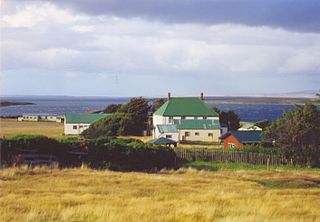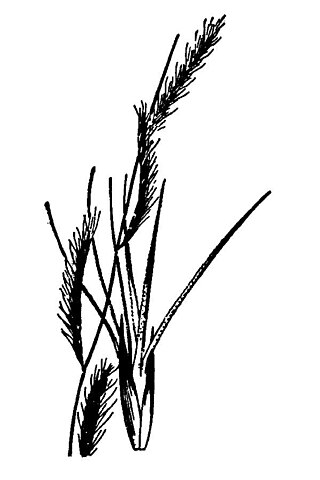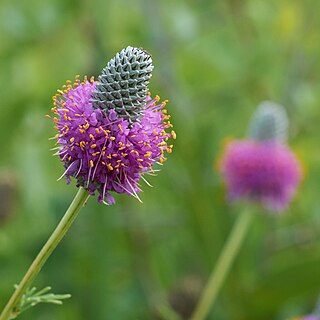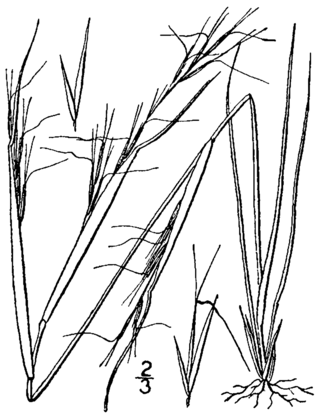
Aristida stricta is a warm-season grass, native to North America, that dominates understory vegetation in sandhills and flatwoods coastal plain ecosystems of the Carolinas in the Southeastern United States. It is known as wiregrass and pineland three-awn grass.

Aristida is a very nearly cosmopolitan genus of plants in the grass family. Aristida is distinguished by having three awns (bristles) on each lemma of each floret. The genus includes about 300 species found worldwide, often in arid warm regions. This genus is among those colloquially called three-awnswiregrasses, speargrasses and needlegrasses. The name Aristida is derived from the Latin "arista", meaning "awn".
Wiregrass is a common name for several plants

Tussock grasses or bunch grasses are a group of grass species in the family Poaceae. They usually grow as singular plants in clumps, tufts, hummocks, or bunches, rather than forming a sod or lawn, in meadows, grasslands, and prairies. As perennial plants, most species live more than one season. Tussock grasses are often found as forage in pastures and ornamental grasses in gardens.

Aristida behriana is a native Australian species of grass commonly known as bunch wire grass or brush wire grass. It is a bright green perennial plant forming short, tufted tussocks up to 40 centimetres (16 in) high. Its seeds have three long, radiating awns; it is a member of genus Aristida, grasses known commonly as three-awns. The species favours low fertility and well-drained soils. It is commonly found in mallee woodlands and plains, where it grows on sunny slopes. Superficially, the flower heads resemble those of the invasive weed African feather-grass. A. behriana is found in all mainland Australian States.

Aristida adscensionis is a species of grass known by the common name sixweeks threeawn. It is native to the Americas but it is distributed nearly worldwide. It grows easily in disturbed and waste areas and has potential to become a weed.

Aristida californica is a species of grass known by the common names California threeawn and Mojave threeawn. It is native to the Mojave Deserts and Sonoran of northern Mexico and California and Arizona.

Aristida divaricata is a species of grass known by the common name poverty threeawn. It is native to the Americas from the central United States to Guatemala. It is a perennial grass forming clumps of unbranched stems up to 70 centimeters tall. Leaves are mostly basal and roll along the edges. The sparse inflorescence is a wide, flat, open array of spikelets that break apart easily. The grain has a twisted tip and three awns up to 2 centimeters long.

Aristida oligantha is a species of grass known by the common names prairie threeawn and oldfield threeawn.

Bouteloua trifida is a species of grass known by the common name red grama. It is native to central and northern Mexico and the Southwestern United States, where it grows in desert scrub and other dry areas.

Hyparrhenia hirta is a species of grass known by the common names common thatching grass and Coolatai grass. It is native to much of Africa and Eurasia, and it is known on other continents as an introduced species. In eastern Australia it is a tenacious noxious weed. In South Africa, where it is native, it is very common and one of the most widely used thatching grasses. It is also used for grazing livestock and weaving mats and baskets.

Linaria purpurea or purple toadflax is a purple-flowered plant native to Italy, part of the plantain family (Plantaginaceae). It is sometimes planted in gardens and is also an introduced weed in North America and other parts of Europe.

Polypogon australis is a species of grass known by the common names Chilean beard grass and Chilean rabbitsfoot grass. It is native to Chile and Argentina. It is also known in parts of the western United States where it is an introduced species and invasive species that grows in moist habitat types such as ditches.

Dalea purpurea is a species of flowering plant in the legume family known as purple prairie clover. Native to central North America, purple prairie clover is a relatively common member of the Great Plains and prairie ecosystems. It blooms in the summer with dense spikes of bright purple flowers that attract many species of insects.

Aristida purpurascens is a species of grass known by the common name arrowfeather threeawn. It is native to eastern North America. One of the three varieties has a distribution extending south into Honduras.
Aristida rhizomophora is a species of grass known by the common name Florida threeawn. It is endemic to Florida in the United States.

Aristida basiramea, the forked three-awn, is a species of grass in the family Poaceae native to North America. The specific epithet basiramea means "branching from base".

Triplasis purpurea, the purple sand-grass, is a species of grass in the family Poaceae native to North America. The specific epithet purpurea is Latin for "purple", referencing the purple spikelets of the grass.
Aristida dichotoma, known as churchmouse threeawn, fork-tip three-awn, pigbutt three-awn, and poverty grass, is a species of grass from eastern North America. It is native to the Eastern and Midwestern United States and Ontario, Canada. It has been introduced in California. It was described in 1803 by André Michaux.

Aristida calycina, commonly known as dark wiregrass, is a species of grass in the family Poaceae that is native in Australia.



















